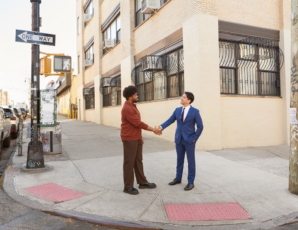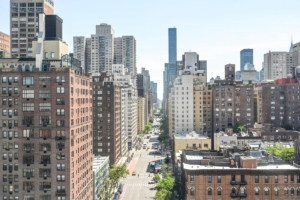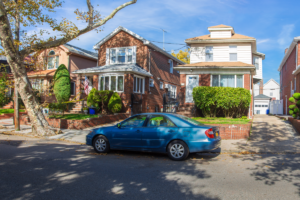The skyline of New York City has seen an abundance of new residential buildings rise in the past few years, but what will happen to the city’s real estate market if rates rise too?
While many expect the Federal Reserve to exit its zero interest rate policy soon, few people understand the effects higher mortgage rates will have on the New York City real estate market. In this post, we look at the question of what is likely to happen when rates rise and why it is likely the answer will be not much.
Given the 20-year inverse relationship between the StreetEasy Price Index for Manhattan and the 30-year mortgage rate, it is easy to think the negative correlation will hold when rates rise. Instead, a gradual rise in rates and a flattening of price appreciation is likely.
[tableau server=”public.tableausoftware.com” workbook=”rateTimeSeries” view=”interestRateWindow” tabs=”no” toolbar=”no” revert=”” refresh=”yes” linktarget=”” width=”610px” height=”415px”][/tableau]
This outcome is driven by two factors. First, according to our analysis of New York City Department of Finance data, just two in five condos purchased in Manhattan are mortgaged. Second, the homeownership rate in the borough is only 23 percent, considerably lower than the citywide or U.S. rate. In the Bronx, Brooklyn and Queens, a higher homeownership rate generally means a greater use of mortgages.
| Mortgage Usage (share of all sales)* | Homeownership Rate (Census) | |
| Bronx | 30.2% | 19.4% |
| Manhattan | 39.8% | 22.8% |
| Brooklyn | 54.0% | 29.8% |
| Queens | 39.7% | 44.2% |
A recent report by the New York Federal Reserve found that housing demand is more sensitive to a change in the down payment requirement than it is to changes in the mortgage rate. This finding suggests that liquidity constraints have a larger impact on buying decisions than the nominal cost of a mortgage.
Another factor to consider is that, in New York City at least, the down payment usually increases as the home’s purchase price increases. The median loan-to-value (LTV) ratio* for all condos in Manhattan is 69 percent, meaning a condo buyer’s down payment represents 31 percent of the purchase price (or value of the home) and the remaining 69 percent is covered by a loan. This, however, varies by price tier across the borough. Manhattan condos priced in the bottom tier typically have an LTV ratio of 74 percent, while those priced in the middle and top tiers have LTV ratios of 69 percent and 65 percent, respectively. The pattern of a higher down payment among higher priced homes is consistent across all of New York’s boroughs and submarkets, as broken down in this chart:
| Median Recorded Sale Price | Use of Mortgages | Median LTV | Bottom Tier LTV | Middle Tier LTV | Top Tier LTV | |
| Manhattan (All) | $1,195,500 | 40% | 69% | 74% | 69% | 65% |
| Downtown | $1,525,486 | 43% | 69% | 71% | 70% | 65% |
| Midtown | $1,033,570 | 33% | 69% | 70% | 68% | 66% |
| Upper East Side | $1,422,574 | 37% | 66% | 69% | 68% | 63% |
| Upper Manhattan | $593,262 | 56% | 78% | 79% | 78% | 76% |
| Upper West Side | $1,414,296 | 36% | 68% | 70% | 69% | 65% |
| Bronx (All) | $294,171 | 30% | 80% | 80% | 86% | 80% |
| Brooklyn (All) | $630,148 | 54% | 75% | 79% | 76% | 72% |
| North Brooklyn | $698,387 | 51% | 75% | 76% | 76% | 72% |
| Northwest Brooklyn | $836,700 | 62% | 75% | 77% | 77% | 72% |
| Prospect Park | $818,674 | 62% | 75% | 78% | 74% | 71% |
| East Brooklyn | $445,469 | 60% | 81% | 97% | 80% | 76% |
| South Brooklyn | $453,992 | 43% | 74% | 73% | 74% | 74% |
| Queens | $436,098 | 40% | 72% | 73% | 72% | 72% |
The inverse relationship between the median closing price and the median LTV ratio is seen here:
[tableau server=”public.tableausoftware.com” workbook=”loanToValue” view=”ltvWindow” tabs=”no” toolbar=”no” revert=”” refresh=”yes” linktarget=”” width=”610px” height=”515px”][/tableau]
While it’s anybody’s guess as to when interest rates will increase and by how much, the overall impact on the real estate market in New York City is likely to be small. Many buyers in the city simply do not use mortgages. For those that do take out a loan, they often make a sizeable down payment that lowers the overall LTV ratio. The large down payment that is required to close on New York City homes will likely weigh heavier in the minds of renters who are mulling the decision to buy. Unlike the rising skyline of the city, rising rates are unlikely to get much notice.
Future posts in this series on potentially rising mortgage rates and the impact on the city’s real estate market will look at the improving job market, credit availability, the phenomenon known as ‘rate lock-in,’ and the mortgage interest tax-deduction.
Note: All mortgage, recorded sale price, and LTV data are for condominiums only and based on data provided by the New York City Department of Finance.
*Loan-to-value (LTV) ratio is a financial term used by lenders to express the ratio of a loan to the value of an asset purchased.









